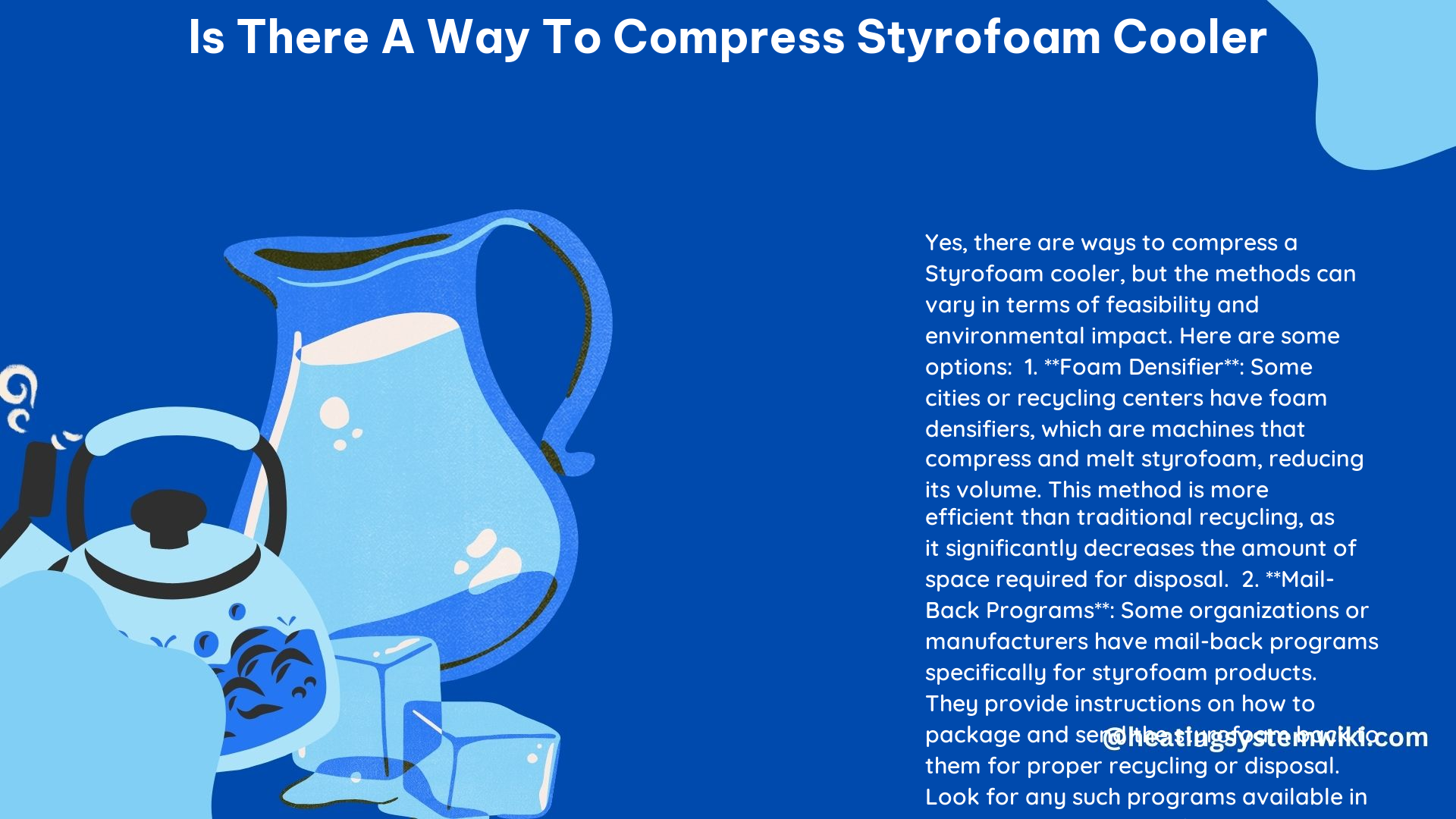Styrofoam coolers are a common household item, but they can be bulky and take up a lot of space when it comes to disposal. Fortunately, there are several methods to compress a Styrofoam cooler, making it easier to handle and dispose of. In this comprehensive guide, we’ll explore the various techniques for compressing Styrofoam coolers, including their technical specifications, advantages, and drawbacks.
Manual Compression
One of the simplest ways to compress a Styrofoam cooler is through manual compression. This method involves applying physical pressure to the cooler, either by stepping on it or using a heavy object to press down on it. While this approach is straightforward, it may not result in a significant reduction in size, and it can be time-consuming and physically demanding.
To manually compress a Styrofoam cooler, follow these steps:
- Place the cooler on a flat, stable surface.
- Apply your body weight by standing on the cooler or use a heavy object, such as a book or a piece of furniture, to press down on the cooler.
- Continue applying pressure until the cooler is as compact as possible.
The effectiveness of manual compression will depend on the size and thickness of the Styrofoam cooler. Larger and thicker coolers may require more force to achieve a noticeable reduction in size. As a general guideline, a small Styrofoam cooler (approximately 12 x 12 x 12 inches) can be manually compressed to around 6 x 6 x 3 inches, reducing its volume by roughly 75%.
Acetone Method

Another method for compressing Styrofoam coolers involves the use of acetone, a highly flammable solvent. When Styrofoam is exposed to acetone, it begins to dissolve, allowing the material to be compressed into a smaller, denser form.
However, it’s important to note that the acetone method is not eco-friendly and can be dangerous if not handled properly. Acetone is a volatile substance, and the fumes can be harmful if inhaled. Additionally, the dissolved Styrofoam can create a sticky, messy residue that requires careful cleanup.
To use the acetone method, follow these steps:
- Place the Styrofoam cooler in a well-ventilated area, such as outdoors or in a fume hood.
- Pour a small amount of acetone (approximately 1/4 cup per 12 x 12 x 12 inch cooler) into a container.
- Submerge the Styrofoam cooler in the acetone and allow it to sit for several minutes, or until the material begins to dissolve.
- Carefully remove the cooler from the acetone and allow it to dry completely.
- Once dry, the compressed Styrofoam can be disposed of or repurposed as needed.
The acetone method can reduce the volume of a Styrofoam cooler by up to 90%, but the exact reduction will depend on the size and thickness of the cooler. It’s important to exercise caution when using acetone and to follow all safety guidelines to prevent accidents or exposure to harmful fumes.
Recycling Programs
Many companies and laboratories have polystyrene cooler take-back programs, which allow you to return used Styrofoam coolers for recycling. These programs are generally more eco-friendly than the acetone method, as they divert the Styrofoam from landfills and provide a sustainable disposal option.
To utilize a recycling program, follow these steps:
- Locate a nearby polystyrene cooler take-back program by contacting your local waste management department or searching online.
- Prepare the Styrofoam cooler for return by removing any non-Styrofoam materials, such as lids or liners.
- Transport the cooler to the designated drop-off location or arrange for pickup if the program offers that service.
The specific measurements and technical details of the compressed Styrofoam from recycling programs can vary depending on the program and the equipment used. Some programs may provide information on the size and weight of the compressed Styrofoam blocks, while others may not disclose these details.
Compression Machines
For a more efficient and consistent compression of Styrofoam coolers, specialized compression machines can be used. These machines are designed to apply heat and pressure to the Styrofoam, compacting it into small, dense blocks that are easier to handle and dispose of.
Compression machines typically work by feeding the Styrofoam cooler into a hopper, where it is then heated and compressed using a piston or other mechanical mechanism. The resulting compressed Styrofoam blocks can be as small as 4 x 4 x 2 inches, with a weight of around 1 pound, depending on the machine’s specifications and the size of the original cooler.
While compression machines can provide a significant reduction in Styrofoam volume, they can also be expensive, ranging from a few hundred to several thousand dollars, depending on the model and features. Additionally, these machines may not be practical for individual household use and are more commonly found in commercial or industrial settings.
Repurposing Styrofoam Coolers
If you’re looking for a more eco-friendly alternative to compressing Styrofoam coolers, consider repurposing them for other uses. Styrofoam can be a versatile material, and there are many creative ways to give it a second life, such as:
- Using it as packing material for fragile items
- Crafting it into decorative pieces or sculptures
- Utilizing it as insulation for DIY projects
- Incorporating it into gardening or landscaping projects
By repurposing Styrofoam coolers, you can reduce waste and find new uses for this material, rather than simply compressing and disposing of it.
In conclusion, there are several methods available for compressing Styrofoam coolers, each with its own advantages and drawbacks. Whether you choose manual compression, the acetone method, recycling programs, or compression machines, it’s important to consider the environmental impact and safety concerns associated with each approach. By exploring these options and considering repurposing alternatives, you can find the best solution for your Styrofoam cooler disposal needs.
References:
– Compacting Styrofoam and Discarding It
– Resources for Recycling Expanded Polystyrene
– How to Dispose of Styrofoam
– Styrofoam Compactor Machine
– Uses for Small Styrofoam Pieces
